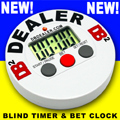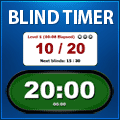|
|
How To Seat Poker PlayersSeating poker playersSeating your players will depend on the size of your poker tables and the total number of players. Players should be distributed as evenly as possible between all tables. Most full-size oval poker tables can comfortably seat 10 players and most round or octagonal poker tables can comfortably seat 6 or 8 players. Eight, 9, or 10 players per table is optimal from a play of poker perspective. Five players is barely acceptable and six-handed is considered a short-handed table. Eleven players is sometimes used and the maximum that I have ever heard of is 13 players at a hold'em poker table. Keep in mind that a dedicated dealer (rather than a dealer/player) will take up one seat at your poker table. More than one tableIf you have more than one table in play, you must decide how you will combine tables as players are eliminated. The easiest method to combine tables is at preset times. For example - you will go from 3 tables down to 2 tables when there are 20 players remaining in the tournament and you will go down from 2 tables to 1 table when there are 10 players remaining. You will have to seat your players according to the size and shape of your poker tables but this is how you should attempt to seat your players ... Less than 10 players should play at one table Assigning seats to playersPrepare a deck of cards consisting of one card for each seat at each table. For example, if you have two tables of 8 players and one table of 9 players, use a deck consisting of the A-8 of spades (Table1), the A-8 of hearts (Table2), and the A-9 of clubs (Table3). When the tourney begins, or when a new table or tables are formed, each player draws a single card. The ace is seated at the button, the 2 is seated at the small blind, the 3 is seated at the big blind, then each player is seated in proper card order around the table. Card suit is used to determine which table a player is seated at - for example, all spades sit at Table1, all hearts sit at Table2, and all clubs sit at Table3. If you have more than four tables of players, or cannot use a deck of cards to assign seats, use a seat number written on a piece of paper instead. Assign a letter of the alphabet to each table (Table A, Table B, Table C, etc.,). Give each player a piece of paper with a seat assignment written on it - A5 or C7 or D1, etc.. Seat A1 is the first seat (and the button) at Table A, Seat A2 is the small blind at Table A, Seat C3 is the big blind at Table C, Seat B4 sits one seat to the left of the big blind at Table B, etc.. Assigning seats to dealersYou will probably have a dealer/player in your game rather than a dedicated dealer. You want the dealer/player to sit in the middle of the table to make it easier to handle the chips in the pot and to make it easier for all players to see the community cards. If you want three dealers to each sit at three different tables, you first divide your prepared deck of cards into three stacks - one stack of spades, one stack of hearts, and one stack of clubs. Each dealer then randomly draws one card from a different stack and sits in the middle seat at the appropriate table. You then combine all the remaining cards together for the non-dealers to draw from. Each player draws a card and then sits, in proper card order, around the dealer. In other words, the dealer chooses his card first and sits in the middle of the table, all the other players then choose their cards and sit in proper order around the dealer. Assigning a seat to the Tournament DirectorThe Tournament Director will constantly have to issue rebuys, move players, and perform other duties that will make it necessary to leave his seat and move about the room. As the host of the tournament, I sit in a seat “Reserved for the Tournament Director”. I choose a seat that makes it easy to get up from the table to perform various hosting duties - you don’t want to be blocked in and force other players to move each time you need to get up from the table. Place a sign or marker on the seat that you want to reserve for the Tournament Director. This special seating will not be any advantage to the Tournament Director since all the other players will be randomly seated around this reserved seat. Poker seating example:
Moving players between tablesYour tables might become imbalanced as players are eliminated from your tournament. See my Moving Poker Players page for information on how to move players between tables and how to seat the final table.
|
Online Poker Guide
Hand Converter
Holdem strategy
Freeroll tournaments
Poker calculator
Online poker
Poker rooms
> poker pokeren
> iDeal poker
> online casino
> iDeal casino
> casino casinos
> casino bonus
Get Bonus code Titan Poker, and full tilt poker referral code or max bonus to the full tilt referral code. Best ultimate bet referral code sign up bonus doyles room promo code or poker host bonus code























